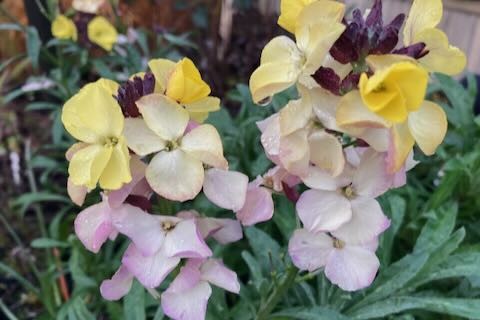- Out-of-Stock



Pretty variety that begins soft yellow then fades as the flowers age. Prolific flowering during winter, liking drained soils and drying out a little in summer. Cut back fairly hard early summer to around 2/3 to half height to keep compact. Looks terrific in mass plantings like all the wallflowers.
Pretty variety that begins soft yellow then fades as the flowers age. Prolific flowering during winter, liking drained soils and drying out a little in summer. Cut back fairly hard early summer to around 2/3 to half height to keep compact. Looks terrific in mass plantings like all the wallflowers.
Data sheet
A pretty variety we raised a few years ago from experimental crosses, with some creative contributions from our staff for the name. Good clumping habit and a subtle colour.
Low growing bedding and border plant with blue flowers, lasts well in a vase and keeps producing if deadheaded.
Hand pollinated seedlings from our best dark flowered plants from imported stock.
Lovely grape hyacinth for gardens or pots, vigourously clumping and easy, early spring flowering bulbs. Clump of flowered bulbs in each pot ready to plant.
One of the earliest fruiting varieties, with tall vigorous growth habit to 2.1m. Once established, prune out central canes to keep bush open. As with most blueberries, fruit production is improved by planting other varieties nearby. Sweet fruit which stores and freezes well, perfect for jams, pies, or just eaten fresh.
A beautiful medium height triandrus cultivar with white flowers in spring, one of our favourite narcissus.
A useful pond side plant or for wet soils, where it will form a dense ground cover. Bright green leaves and red flowers during summer.
Papaver Choir Boy produces beautiful white poppies with black central blotches, grow in fertile moisture retentive clay based soil and allow to dry out over late summer. Not for pots.
A good multiplier with a understated greenish bronze colour, nice and subtle.
Low mounding perennial for foreground colour, useful ground cover when mass planted at 25cm spacings under roses and along pathways. White form with pink eye, long flowering. Combine with dianthus helianthemum and miniature bulbs.
Much improved form of the regular white Siberean iris, with larger flowers and a stronger growth habit. Likes moist fertile soil, border or pond margin, we imported from the UK in mid 90s.
A striking biennial for shade, forming strong mounds of good foliage and normally flowers in second or third year once the plant has acheived maturity, after which it will self seed. This is the rarely offered white form, the common form is pink.
Medium height violet aster, prolific flowering in autumn. Easy cultivation as with other varieties
A pretty and long flowered plant for a damp soil in a sheltered position forms a nice clump. Grows well amongst other perennials or under roses.
A beautiful low compact variety for edging or foreground, virtually evergreen and flowers for a long time. Prefers heavier moisture retentive soil types, and a cooler position is best although will take both full sun or part shade.
Our own cross from this wonderful alpine which we have increased from division. Beautiful indigo shading to purple, free flowering and vigourous once established. Best in well drained conditions in a pot or the rock garden.

Pretty variety that begins soft yellow then fades as the flowers age. Prolific flowering during winter, liking drained soils and drying out a little in summer. Cut back fairly hard early summer to around 2/3 to half height to keep compact. Looks terrific in mass plantings like all the wallflowers.